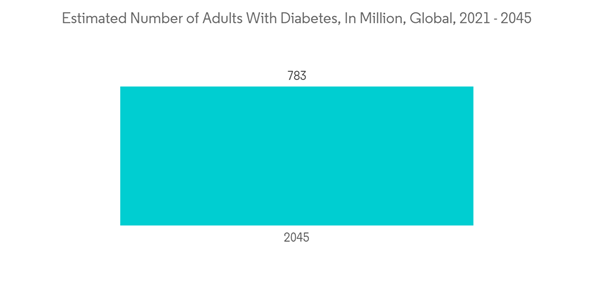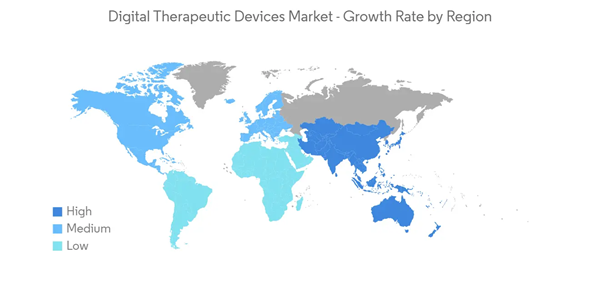The outbreak of COVID-19 has also prompted healthcare professionals to seek alternatives to traditional systems and procedures. This leads to the rapid adoption of digital medical care across the industry from providers to consumers. As non-essential requirements are given low priority during the pandemic, patients turn to digital therapeutic solutions. In May 2020, a research study published titled "Digital physical therapy in the COVID-19 pandemic" stated that the worldwide COVID-19 pandemic forced the Brazilian health system to promptly adopt telehealth in different health care areas. Treatment efficacy and patient evaluation using digital practice were already investigated for some acute and chronic musculoskeletal conditions, cardiac conditions, neurological problems, post-surgical rehabilitation, pain management, pelvic floor conditions, and respiratory dysfunctions. Hence, increasing research studies would provide insight into the impact of COVID on the market. Thus, the market will grow in upcoming future.
According to the study 'The Longitudinal Ageing Study in India (LASI)' published in January 2021, approximately 75 million ages above 60 years of age suffer from some chronic disease. About 45 million have cardiovascular disease and hypertension and about 20 million suffer from diabetes. Thus, the high prevalence of chronic diseases in the country will boost the demand for cost-effective therapeutics such as digital therapeutic devices, thus driving the studied market. There has been a rise in the use of technology for therapeutics for medical conditions. Consumers in developed markets are increasingly aware of the advanced products for the treatment of medical conditions. In July 2019, according to the Organization for Economic Co-operation and Development, healthcare spending as a share of GDP has increased significantly in 2020, as the economic situation worsened and health spending increased in many OECD countries. Preliminary health spending for a group of 16 countries suggest that per capita health increased by around 4.9% on average in 2020. The preference is also, therefore, shifted toward the advanced services in the medical field, including the growing demand for innovations in therapeutic devices. Product apporval are another factor for the growth of the market. For instance, in December 2020, the United States Food and Drug Administration awarded a De Novo marketing authorization to San Francisco and London-based Mahana Therapeutics for a product called Parallel, which according to company materials is an 8-week cognitive behavioral therapy program for people with irritable bowel syndrome. Such approvals will increase the market growth.
The companies are also increasingly rising on venture investments in this domain, which drives this market. Factors, such as patient's data privacy concerns associated with digital therapeutic devices, hinder the growth of this market.
Digital Therapeutic Devices Market Trends
Treatment/Care Segment is Expected to Witness a High Growth Over the Forecast Period
During the pandemic, there has been a growing need for patients to take control of their own situation and respond in real-time, while their doctor still needs to monitor their case remotely. Therefore, digital therapeutic devices increased in demand. The outbreak of COVID-19 has increased patient reliability in digital applications to play an active and informed role in their health care. Digital treatment solutions have helped reunite patients with doctors. Therefore, it can be concluded that digital health tools prove to be very useful for patients with chronic illnesses and medical professionals.One of the key factors contributing to the growth of this category is the partnerships by key market players. For instance, in January 2021, Hydrus 7 Lab signed a strategic partnership with European Digital Health company, Epillo. Such initiatives would increase market growth in the future.
The growing burden of chronic disorders increases the segment growth. according to the International Diabetes Federation (IDF), in 2021, approximately 536 million adults (between the ages of 20-79 years) were living with diabetes globally, and this will rise to 783 million by 2045. The proportion of people with type 2 diabetes is increasing in most countries, and 79% of adults with diabetes were living in low- and middle-income countries, where 1 in 5 people above the age of 65 years have diabetes. The proportion of people with type 2 diabetes is increasing in most countries, and 79% of adults with diabetes were living in low- and middle-income countries, where 1 in 5 people above the age of 65 years have diabetes.
North America is Expected to Dominate the Market During the Forecast Period
North America is expected to dominate the market, owing to the early adoption of new technologies and rising investment through funding in this region. The funding is associated with a rising investment from the government, venture capitalists, mergers, and acquisitions.In April 2020, the United States Food and Drug Administration (US FDA) issued guidelines to increase the availability of digital medical devices for mental health. With this in mind, the FDA aimed to subsidize people who followed home segregation guidelines or practiced social isolation without needing a clinic visit during the COVID-19 public health emergency. This will also reduce the burden on health care facilities and reduce the risk of exposure to the virus. Such initiatives by the government boost the market growth in the region.
The acquisition is another factor in the growth of the market. For instance, in February 2021, Philips announced the acquisition of BioTelemetry, Inc., one of the leading United States-based providers of remote cardiac diagnostics and monitoring. Product approval is another factor in the growth of the market. For instance, in June 2020, MedRhythms, a Portland, Maine-based digital therapeutics company received Food and Drug Administration clearance for its patented digital therapeutic to treat chronic stroke walking deficits. These intiatives will increase the market growth in the futrue.
Furthermore, an increase in the geriatric population, a rise in incidences of chronic diseases, the surge in demand for wireless and portable systems, and the availability of a sophisticated reimbursement structure that aims to reduce expenditure are few more factors boosting regional growth. For instance, in January 2021, as per the National Center for Chronic Disease Prevention and Health Promotion, 6 in 10 adults in the United States have a chronic disease and 4 in 10 adults have two or more chronic diseases and these conditions are posing around USD 3.8 trillion of healthcare costs on the country's healthcare system every year. Hence, due to above mentioned factors the market is likely to grow in the future.
Digital Therapeutic Devices Industry Overview
The digital therapeutic devices market is competitive, with quite a number of major players. The rising number of market players is intensifying the competition. The companies are also working in partnership with many employers, payers, healthcare systems, and pharma companies. Some of the major players are Philips NV, Omada Health Inc., WellDoc Inc., LIVONGO HEALTH, Pear Therapeutics, Noom Health Inc., etc.Additional Benefits:
- The market estimate (ME) sheet in Excel format
- 3 months of analyst support
This product will be delivered within 2 business days.
Table of Contents
Companies Mentioned (Partial List)
A selection of companies mentioned in this report includes, but is not limited to:
- 2Morrow, Inc.
- BigHealth
- Canary Health
- Koninklijke Philips NV (BioTelemetry Inc.)
- Livongo Health
- Mango Health Inc.
- Noom Health Inc.
- Omada Health Inc.
- Pear Therapeutics
- Propeller Health
- Twine Health Inc.
- WellDoc Inc.










